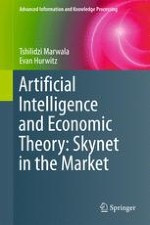2017 | OriginalPaper | Chapter
5. Behavioral Economics
Authors : Tshilidzi Marwala, Evan Hurwitz
Published in: Artificial Intelligence and Economic Theory: Skynet in the Market
Publisher: Springer International Publishing
Activate our intelligent search to find suitable subject content or patents.
Select sections of text to find matching patents with Artificial Intelligence. powered by
Select sections of text to find additional relevant content using AI-assisted search. powered by
